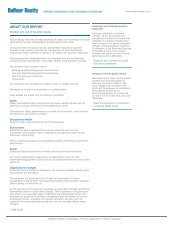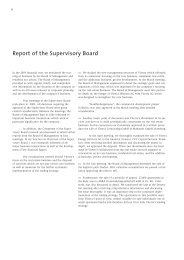E_mg_GB_03_vorne-29_3_04
E_mg_GB_03_vorne-29_3_04
E_mg_GB_03_vorne-29_3_04
You also want an ePaper? Increase the reach of your titles
YUMPU automatically turns print PDFs into web optimized ePapers that Google loves.
MANAGEMENT SHARE STRATEGY SPECIAL SECTION MANAGEMENT REPORT FINANCIAL STATEMENTS FURTHER INFORMATION<br />
Consolidated Balance Sheets • Statements of Income • Statements of Cash Flows • Statements of Changes in shareholders’ Equity • Fixed Assets Schedule • Notes • Independent Auditors’ Report<br />
15) Derivatives and Financial Instruments<br />
a) Use of Derivatives and Financial Instruments<br />
In its day-to-day financial management, the <strong>mg</strong> Group uses all customary forms of investments,<br />
such as fixed-term deposits, fixed-income securities and mutual funds. The Group funds its operations,<br />
among other things, through bank loans, factoring arrangements and ABS transactions.<br />
The <strong>mg</strong> Group uses derivatives to mitigate the risk of adverse movements in interest rates, share<br />
prices and other investments.<br />
Forward exchange deals and currency options are largely used to hedge assets, liabilities and firm<br />
buy or sell commitments in foreign currency and, to a lesser degree, to hedge forecasted transactions<br />
denominated in foreign currency. Hedges are used to mitigate the risk of adverse movements in the<br />
exchange rates of certain currencies, especially the U.S. dollar and pound sterling.<br />
Interest rate swaps and options are used to hedge the interest rate risk inherent in liabilities to banks.<br />
Commodity derivatives are used primarily in the discontinued chemicals trading business to mitigate<br />
the risk inherent in commodities prices.<br />
b) Fair Value of Financial Instruments<br />
The fair value of a financial instrument is the price at which a counterparty is willing to assume<br />
the rights and/or obligations arising from this financial instrument from another counterparty. Fair<br />
values have been computed on the basis of the market information available at the balance sheet<br />
date and the valuation methods outlined below, which are based on certain assumptions. Because<br />
of the varying factors influencing them, the fair values stated here may differ from the values that<br />
can be realized in the market at the present time.<br />
Original financial instruments<br />
Securities: Fair value is the market price.<br />
Cash and cash equivalents: Owing to their short maturity, the nominal values of cash and cash<br />
equivalents correspond to their fair value.<br />
Financial liabilities: The fair value of listed debt securities is their market price. The fair value of<br />
other long-term bonds corresponds to the present value of future anticipated cash flows. The discount<br />
rate used is the current market interest rate on bonds of the same maturity. Owing to their short<br />
maturity, it is assumed that the nominal value of bonds and loans under revolving credit facilities<br />
approximates to their fair value. It is generally assumed that the nominal value of floating-rate loans<br />
corresponds to their fair value.<br />
Receivable from direct capital lease: As the current market interest rate was used to calculate the<br />
present value of the receivable, the fair value and nominal value of the receivable are the same.<br />
135









